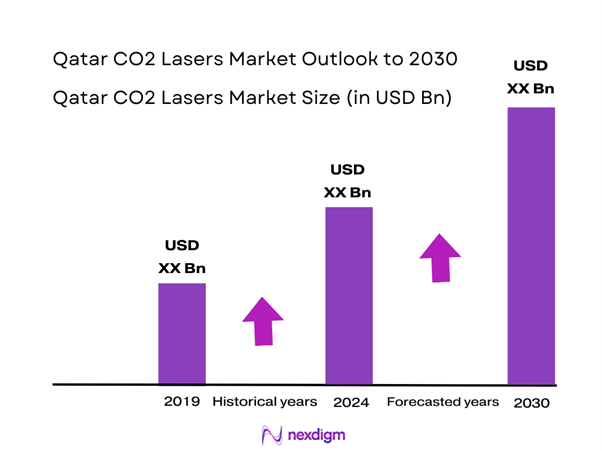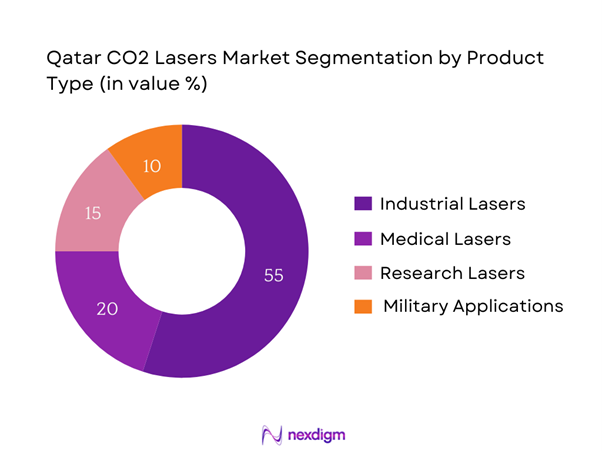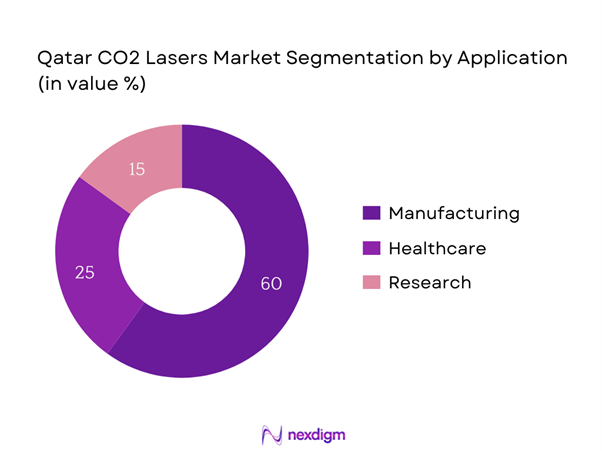Market Overview
The Qatar CO2 Lasers Market is valued at USD 21.43 million in 2025 with an approximated compound annual growth rate (CAGR) of 7.06% from 2025-2030, based on a five-year historical analysis. This market growth is driven primarily by the increasing applications of CO2 lasers across sectors such as manufacturing, healthcare, and research. The demand for precision and efficiency in processes like cutting and engraving propels market growth, supported by government initiatives to enhance technology adoption in various industries. Furthermore, the rising investments in healthcare, estimated at USD 18 billion, directly contribute to the expansion of the CO2 lasers market as hospitals and clinics integrate advanced technologies into their operations.
Dominant cities in the Qatar CO2 lasers market include Doha and Al Rayyan. Doha, as the capital and largest city, has a high concentration of industrial facilities and healthcare institutions that utilize CO2 lasers extensively. The government’s commitment to diversifying the economy and investing in high-tech manufacturing creates an environment conducive to the growth of laser applications. Al Rayyan complements this by its rapid industrial growth, as emerging manufacturing sectors increasingly rely on precision tools like CO2 lasers.

Market Segmentation
By Product Type
The Qatar CO2 lasers market is segmented by product type into industrial lasers, medical lasers, research lasers, and military applications. The industrial lasers sub-segment dominates the market, accounting for a significant share. This dominance stems from the extensive use of industrial CO2 lasers in various sectors, including automotive and electronics manufacturing, where precision cutting and engraving are critical. As industries focus on automation and efficiency, the demand for high-performance lasers continues to rise, thereby securing industrial CO2 lasers’ position as the market leader in this segment.

By Application
The Qatar CO2 lasers market is also segmented by application into manufacturing, healthcare, and research. Within this segmentation, the manufacturing sector holds a major share due to its critical reliance on precision marking and cutting processes. CO2 lasers are extensively adopted for their capability to rapidly process a variety of materials, including metals, plastics, and wood. The growing trend toward automation in industrial processes drives the increasing adoption of CO2 lasers, as companies seek to enhance production efficiency and maintain high-quality standards. This substantial demand reinforces the manufacturing application’s predominant position in the market.

Competitive Landscape
The Qatar CO2 lasers market is characterized by the presence of both local and international players, which contributes to a competitive yet evolving landscape. Key companies include Raycus, Coherent Inc., Synrad, Lumentum, and TRUMPF. These companies play a crucial role in driving technological innovation and establishing robust supply chains that enhance the availability and capabilities of CO2 laser systems in the region.
| Company | Establishment Year | Headquarters | Market Specific Parameter 1 | Market Specific Parameter 2 | Market Specific Parameter 3 | Market Specific Parameter 4 | Market Specific Parameter 5 | Market Specific Parameter 6 |
| Raycus | 2007 | Guangdong, China | – | – | – | – | – | – |
| Coherent Inc. | 1966 | Santa Clara, USA | – | – | – | – | – | – |
| Synrad | 1986 | Mukilteo, USA | – | – | – | – | – | – |
| Lumentum | 2015 | Milpitas, USA | – | – | – | – | – | – |
| TRUMPF | 1923 | Ditzingen, Germany | – | – | – | – | – | – |

Qatar CO2 Lasers Market Analysis
Growth Drivers
Technological Advancements
The advancement of laser technologies is perhaps the most significant growth driver for the Qatar CO2 lasers market. In recent years, the global laser industry has grown to approximately USD 15 billion, with great innovations in laser manufacturing and applications across industries such as electronics, automotive, and healthcare. Qatar’s focus on adopting advanced technologies, reflected in its National Vision 2030, promotes the integration of cutting-edge solutions in its industrial landscape. The country’s expenditure of USD 11 billion on technological innovation sets a robust framework for advancements in laser technologies. Increased R&D investments support breakthroughs in CO2 laser efficiency and applications, thereby fueling market growth.
Rising Demand in Medical Sector
The medical sector is witnessing an upsurge in the demand for CO2 lasers, primarily due to their precision and effectiveness in surgical procedures. The global medical devices market is projected to reach USD 500 billion. In Qatar, healthcare spending is estimated at USD 18 billion in 2024, marking a significant growth trajectory with increasing investment in health infrastructure. The integration of CO2 lasers in dermatology, plastic surgery, and minimally invasive procedures contributes to this rise, as technologies enhance operational efficiencies. Furthermore, the growth of Qatar’s medical tourism, which is expected to attract approximately 440,000 visitors by end of 2025, bolsters the demand for sophisticated surgical equipment, including CO2 lasers.
Market Challenges
High Initial Investment Costs
High initial investment costs represent a substantial challenge for the Qatar CO2 lasers market. The average cost of a high-quality CO2 laser system can reach up to USD 100,000, which can hinder adoption for smaller businesses. Furthermore, the manufacturing sector in Qatar has been marked by fluctuating raw material prices, which affected the operational costs of production equipment. As noted by the Qatar Chamber of Commerce, manufacturing costs are estimated to increase by around 5% annually due to volatile market conditions. This financial barrier can restrict the entry of new players and limit growth for existing firms aiming to upgrade their equipment.
Regulatory Compliance and Standardization
Regulatory compliance remains a challenging aspect impacting the CO2 lasers market in Qatar. Government regulations require that all medical devices, including CO2 lasers, adhere to stringent quality and safety standards, which can lead to increased compliance costs for manufacturers. For instance, the Qatar National Standards Organization mandates that medical devices must comply with the ISO 13485 standards for quality management systems. This regulatory landscape can lead to delays in product market entry, impacting innovation timelines. The costs related to maintaining compliance are expected to be around USD 5 million, further straining market dynamics.
Opportunities
Growing Adoption in Emerging Markets
There is a significant opportunity for growth in the Qatar CO2 lasers market through the increasing adoption of these technologies in emerging markets. As these economies develop, the demand for efficient and precise manufacturing solutions rises. In the Gulf Cooperation Council (GCC) region alone, manufacturing is projected to account for about USD 80 billion, reflecting a strong need for modern machinery, including CO2 lasers. Additionally, with Qatar’s strategic location, companies can leverage access to Neighboring markets in the Middle East, creating a broader customer base. This growing industrial landscape in neighboring nations could witness an increased demand for CO2 lasers, providing a pathway for expansion for Qatari manufacturers.
Innovations in Laser Technologies
The ongoing innovations in laser technologies present a robust opportunity for growth in the Qatar CO2 lasers market. Research shows an increase in investments in emerging laser applications and optical technologies globally, reaching approximately USD 22 billion in 2022. In Qatar, the investment in high-precision laser technology is projected to expand, given the country’s commitment to diversifying its economy and boosting technological advancements in sectors such as healthcare and manufacturing. Enhanced CO2 laser capabilities in areas such as speed, efficiency, and application versatility can lead to increased market adoption, supporting the growth trajectory of this market segment.
Future Outlook
Over the next five years, the Qatar CO2 lasers market is expected to exhibit significant growth driven by technological advancements and growing applications in various industries. The government’s focus on expanding manufacturing capabilities and high-tech infrastructure strengthens the foundational environment for the adoption of CO2 laser technologies. Additionally, the ongoing trends toward automation in production processes and vertical integration within industries pave the way for enhanced laser utilization. The healthcare sector is also anticipated to expand usage as hospitals increasingly adopt advanced surgical technologies. These dynamics are expected to establish a robust growth trajectory for the market, allowing it to remain competitive on both regional and global scales, particularly as Qatar continues its efforts to position itself as an innovation hub in the Middle East.
Major Players
- Raycus
- Coherent Inc.
- Synrad
- Lumentum
- TRUMPF
- Newport Corporation
- Fujikura Ltd.
- Laserline GmbH
- Universal Laser Systems
- Epilog Laser
- Trotec Laser
- Gravotech
- MORN LASER
- Osnabrück Laser
- CORONA LASERS
Key Target Audience
- Automotive Manufacturers
- Healthcare Providers (Ministry of Public Health, Qatar)
- Research Institutions
- Government Agencies (Qatar National Standards Organization)
- Manufacturing Companies
- Investments and Venture Capitalist Firms
- Aerospace Companies
- Regulatory Bodies (Qatar Civil Aviation Authority)
Research Methodology
Step 1: Identification of Key Variables
The initial phase involves constructing an ecosystem map encompassing all major stakeholders within the Qatar CO2 Lasers Market. This step leverages extensive desk research utilizing a combination of secondary and proprietary databases to gather comprehensive industry-level information. The primary objective is to identify and define the critical variables influencing market dynamics and to understand the relationships among stakeholders.
Step 2: Market Analysis and Construction
In this phase, historical data pertaining to the Qatar CO2 Lasers Market is compiled and analyzed. This includes assessing market penetration rates among different stakeholders, the ratio of manufacturers to end-users, and the resultant revenue generation. Furthermore, an evaluation of performance metrics is conducted to ensure the reliability and accuracy of revenue estimates.
Step 3: Hypothesis Validation and Expert Consultation
Market hypotheses are developed and subsequently validated through computer-assisted telephone interviews (CATIs) with industry experts representing a diverse array of companies operating in the laser market. These consultations provide valuable operational and financial insights directly from industry practitioners, which are instrumental in refining and corroborating the market data collected.
Step 4: Research Synthesis and Final Output
The final phase involves direct engagement with multiple manufacturers and stakeholders in the CO2 lasers market to acquire detailed insights into product segments, sales performance, consumer preferences, and pertinent factors affecting the market. This direct interaction is crucial for verifying and complementing the statistics derived from the bottom-up approach, thereby ensuring a comprehensive, accurate, and validated analysis of the Qatar CO2 Lasers Market.
- Executive Summary
- Research Methodology
(Market Definitions and Assumptions, Abbreviations, Market Sizing Approach, Consolidated Research Approach, Understanding Market Potential Through In-Depth Industry Interviews, Primary Research Approach, Limitations and Future Conclusions)
- Definition and Scope
- Market Evolution and Historical Context
- Major Players Timeline
- Business Cycle Analysis
- Supply Chain and Value Chain Analysis
- Growth Drivers
Technological Advancements
Rising Demand in Medical Sector - Market Challenges
High Initial Investment Costs
Regulatory Compliance and Standardization - Opportunities
Growing Adoption in Emerging Markets
Innovations in Laser Technologies - Trends
Increasing Application Scope in Various Industries
Sustainability and Eco-Friendly Products - Government Regulation
Safety Standards Compliance
Import Regulations
- By Market Value, 2019-2024
- By Market Volume, 2019-2024
- By Average Price, 2019-2024
- By Product Type (In Value %)
Industrial Lasers
Medical Lasers
Research Lasers
Military Applications - By Application (In Value %)
Manufacturing
Healthcare
Research - By End Use Industry (In Value %)
Automotive
Aerospace
Electronics - By Distribution Channel (In Value %)
Direct Sales
Online Retail
Distributors - By Region (In Value %)
Doha
Al Rayyan
Umm Salal
Al Khor
- Market Share of Major Players, By Value/Volume, 2024
- Cross Comparison Parameters (Company Overview, Business Strategies, Recent Developments, Strength, Weakness, Organizational Structure, Revenues, Revenues by Product Segment, Distribution Channels, Number of Dealers and Distributors, Unique Value Offerings, Regional Presence)
- SWOT Analysis of Major Players
- Pricing Analysis for Major Players
- Detailed Profiles of Major Companies
Raycus
Coherent Inc.
Synrad
Lumentum
Newport Corporation
TRUMPF
Fujikura Ltd.
Laserline GmbH
Universal Laser Systems
Epilog Laser
Trotec Laser
Gravotech
MORN LASER
Osnabrück Laser
CORONA LASERS
- Market Demand and Utilization
- Purchasing Power and Budget Allocations
- Regulatory and Compliance Requirements
- Needs, Desires, and Pain Point Analysis
- Decision-Making Process
- By Value, 2025-2030
- By Volume, 2025-2030
- By Average Price, 2025-2030


